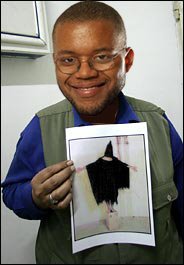On March 11, readers of the New York Times were treated to a splashy front-page article about Ali Shalal Qaissi, the man who was supposedly the hooded prisoner made famous in the Abu Ghraib photos. (Note to fellow bloggers: Use blog-safe Times links. It takes an extra minute, but it's worth it. Times articles are archived after seven days.)
As is now well known, everything about the Times's article was correct. Except for a minor detail: Qaissi was not actually the right man.
The Times this morning had a correction/retraction of the article on the front page and an editors' note attached to the original article.
Since our goal here is to laugh at the misfortunes of the high and mighty, let's reprint a highlighted version of the editors' note:
A front-page article last Saturday profiled Ali Shalal Qaissi, identifying him as the hooded man forced to stand on a box, attached to wires, in a photograph from the Abu Ghraib prison abuse scandal of 2003 and 2004. He was shown holding such a photograph. As an article on Page A1 today makes clear, Mr. Qaissi was not that man.My favorite part is that they try to blame the military for refusing to confirm or deny, when the military had long ago named someone else as the man in the photo.
The Times did not adequately research Mr. Qaissi's insistence that he was the man in the photograph. Mr. Qaissi's account had already been broadcast and printed by other outlets, including PBS and Vanity Fair, without challenge. Lawyers for former prisoners at Abu Ghraib vouched for him. Human rights workers seemed to support his account. The Pentagon, asked for verification, declined to confirm or deny it.
Despite the previous reports, The Times should have been more persistent in seeking comment from the military. A more thorough examination of previous articles in The Times and other newspapers would have shown that in 2004 military investigators named another man as the one on the box, raising suspicions about Mr. Qaissi's claim.
The Times also overstated the conviction with which representatives of Human Rights Watch and Amnesty International expressed their view of whether Mr. Qaissi was the man in the photograph. While they said he could well be that man, they did not say they believed he was.
So to add to the merriment, let me offer a revised version of the photo that ran on March 11.

UPDATE: Welcome to Michelle Malkin's readers. Oh, and if you're interested in other photoshops, I have a bunch on the sidebar under "Photo Comics," which are basically photos with voice-bubbles added. Start with John Roberts.












|